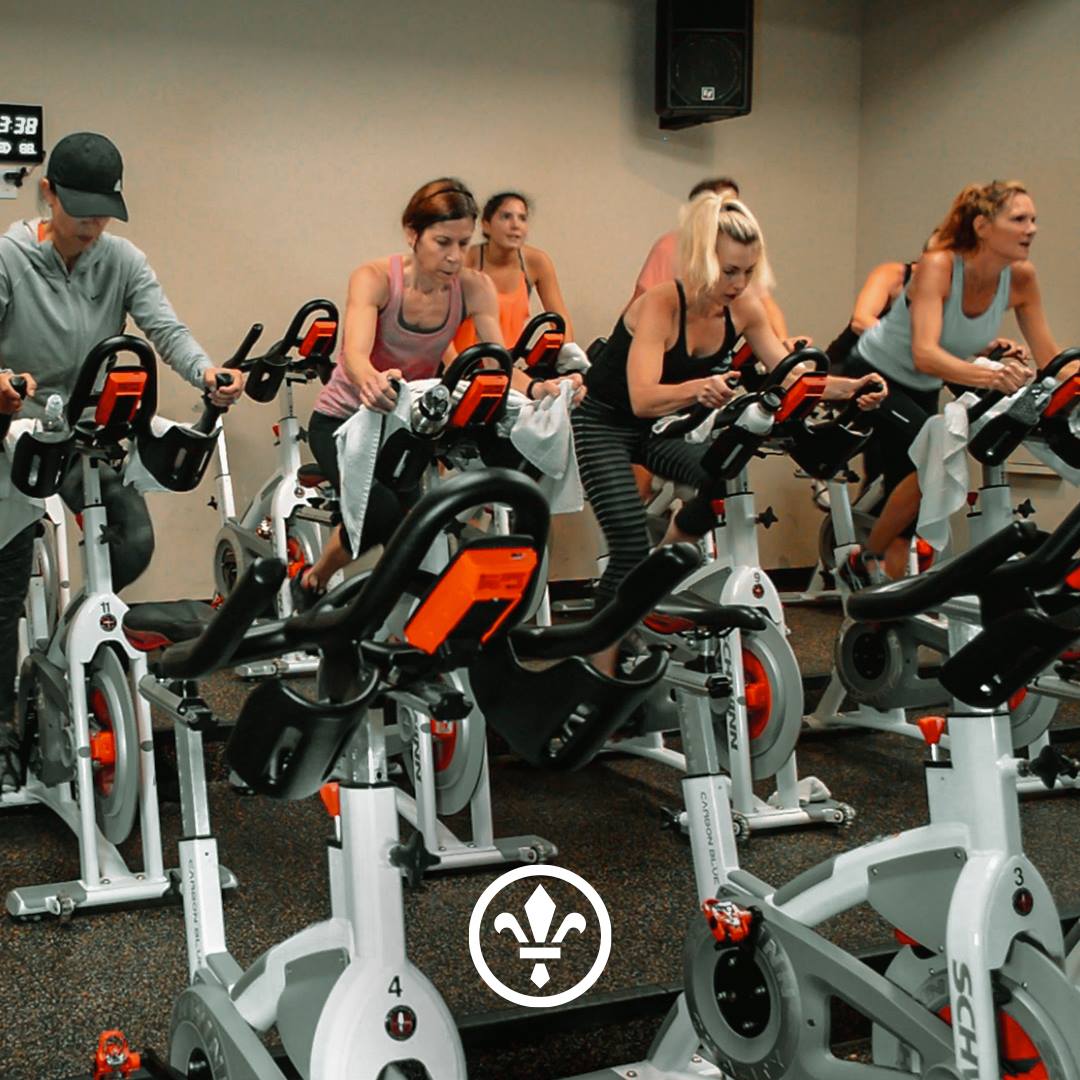
Regular exercise is at the top of everyone’s to-do list, but it is often hard to fit into your demanding schedule. Finding the right workout is often the key to making exercise a top priority.
Cycling for fitness is a great option for people young and old. There are several benefits to your mental, emotional, social, and physical health.
The staff at Paseo Club teaches fitness classes to kids, adults, and seniors and cycle classes are available every day of the week. We know a lot about riding and how it helps people get healthy. We also know that cycling is not for everybody.
But if you are interested in learning more about riding, in this article you can read on and learn why cycling enhances overall well-being and what to expect in your first cycle class.
1. Cardiovascular health
Researchers have discovered that cyclists reduce their chance of heart disease and diabetes. By biking three days a week, people showed a 20% reduction in these pathologies. Biking more often increased the benefits.
In the same study, researchers saw reduced obesity, lower triglyceride levels, and lower blood pressure levels.
Another study showed that doing high-intensity interval training (HIIT) — riders alternating short sprints on their bikes with rest — also increases insulin resistance, VO2 max (how much oxygen you can use during exercise), and lowers blood pressure.
2. Low impact
As you age, your joints become stiffer and less flexible. Movements such as running and jumping become harder on the body and result in more soreness and injury.
It is not uncommon that people in their 40s and older turn away from running, field, and court games to other activities such as swimming and bike riding.
Bike riding is a low-impact form of exercise. You can get all the benefits of building muscles and burning calories without straining your joints.
Some people with a history of knee injuries or are recovering from knee injuries choose to ride because it lubricates the joints and reduces stiffness and soreness. According to Pubmed, cycling "enhances the healing and recovery process.”
3. Muscle building
Biking primarily targets the lower body — quadriceps, glutes, and hamstrings. But your core, back, calves, hips, and even some of your upper body are engaged when you ride too.
The muscle fibers in your legs used in cycle class get the most stimulus and, consequently, will become considerably stronger.
In this study, men and women doing sprint interval training consisting of 4 × 20-second sprints on a bike three times per week for 12 weeks showed quadriceps muscle area increased by 5% and fatigue resistance improved by 4.8%.
4. Burns calories and fat
Researchers had women ride three times per week for six weeks and found that they lost 3.6% of their fat mass within that timeframe.
Harvard did a study comparing different exercises and caloric burn after 30 minutes of activity. They discovered that biking at a moderate speed of 12 to 13.9 miles per hour will cause a 155-pound person to burn 298 calories. If you bike a little faster at 14 to 15.9 miles per hour, a person of the same weight will burn 372 calories.
Biking is much more effective at burning calories than many other forms of exercise. Weightlifting, yoga, stair-step machines, and even high-impact aerobics showed less caloric burn compared to biking.
5. Accessible to beginners through experts
Though it may take time to get used to riding, cycling is a sport that is accessible to people of all abilities. Teens, adults, and seniors can learn to ride and enjoy its benefits.
Indoor cycling gives you the advantage of customizing the level of intensity. If you are new to cycling or not in the best shape, you can lower the resistance of your bike, lessening the intensity.
As you get stronger, you can adjust the resistance level to increase more stimulus, which will help you continue to get fitter.
More experienced riders can select for high intensity to push themselves to greater degrees of challenge and output.
6. Can track progress through apps
One of the satisfying experiences an athlete can have is seeing themselves progress. With modern technology, you can track your progress and monitor important stats such as calories burned, heart rate, power, distance, and more.
Additional features that apps provide are:
- Pre-selected routes that you can choose from
- Rides of varying lengths, often between 20-60 minutes
- Immersive environments provide exciting scenery of New York City, the Swiss Alps, and more
- Many of the apps come with music and playlists to energize you as you sweat
- Live events give you real-time competition — because we all know that training with others helps motivate our game
7. Stress reduction
More and more scientists are discovering how exercise plays a role in mental health. Research shows that regular exercise can reduce depression, reduce stress, decrease feelings of anxiety, improve sleep, and increase moods.
In this study, researchers found that biking 45 minutes to work reduces stress in the morning. (Is this the new cappuccino?)
Another study showed that people with depression could lower their cortisol rates by going on one single bike ride. Cortisol is the hormone that is released in the body when it is experiencing stress or alarm.
According to James Blumenthal, Ph.D., a professor of behavioral medicine at Duke University, “Exercise works as well as psychotherapy and antidepressants in the treatment of depression, maybe better.”
8. Think smarter
New research about bike riding and cognitive processing shows that riding improves memory, reasoning, and planning. This can happen in just 30 minutes of activity three times per week.
Biking helps to create rich capillary beds in the gray matter of your brain. It also gets more nerve cells firing which supports the formation of new brain cells. This literally builds your brain.
The neurotransmitters, the messengers between different parts of your brain, are released, allowing for better communication.
This is especially important news for older adults. As we age, our brains begin to shrink, and connections weaken. Biking can keep our brains younger and more limber — just as it does for our bodies.
9. Builds a sense of community and forms social connections
Working out with a group creates camaraderie, facilitates friendships, and enhances a sense of accountability. There is nothing like knowing your instructor and co-bikers are rooting you on, encouraging you during the hills, and celebrating the victory of a class well done.
The benefits of group classes go beyond the physical. In older adults, it was found that group exercise helps them feel “socially connected and experience a sense of security in the community through caring for others and supporting each other.”
Research shows that group exercise affects how we feel. In fact, this study shows that group exercise reduces stress by 26.2%. That is a one-fourth reduction of whatever stress level you are currently walking around with.
A study that compared rowing with teammates versus rowing solo, discovered that being active with teammates significantly increased participants' pain threshold.
10. Builds mental toughness
We are challenged constantly in life. It can be the small things like getting your kindergartener to pick up their legos before bed or the large difficulties such as a loss in the family or having to move.
Mental toughness (MT) has been studied as an important factor that allows people to deal effectively with challenges and persevere under pressure.
The concept of MT is primarily associated with sports, but its impact is now being recognized for being important in a wide range of other domains, including, education, work, and social situations.
When you challenge yourself physically, the same strategies that you use for intense sprints, hill climbs, or long distances can be applied to obstacles in life.
Mental toughness is much like exercising a muscle. The more you develop it, the more capable you become.
11. Instructor-led group class gets you, fitter, faster
When you exercise in a group class you have all of the fun and support of your peer group, as previously discussed. But how does having an instructor affect your fitness level?
There are many benefits to working under the supervision of a coach or instructor.
- Helps ensure you have proper form
- Makes corrections to prevent injuries
- Pushes you to your limits
- Scales movements that you cannot safely do
- Customize the workouts for target areas
- Supports you in proper mobility and cool-down exercises
It turns out that instructor-led classes accelerate reaching your fitness goals. In this study of medical students, after 12 weeks of instructor-led group exercise, they reported a 24.8% improvement in their physical fitness.
12. All-weather workout
We all love a nice jog, hike, or bike ride in the fresh air. But depending on where you live, it is often too hot, too cold, or too wet to exercise outdoors.
Exercise is an afterthought for many people. Once you work, play with the kids, pet the dog, cook dinner, and wash the dishes, exercise is the last thing on your mind. We know we are supposed to exercise regularly, but how can we fit it in?
If the weather is inclement, the obstacles to physical fitness are even greater.
That is why cycle class at your local fitness center is an important option for year-round workouts. This makes exercise more accessible which means you will be more likely to attend class. Thereby you get the physical activity you so desperately want.
What to expect at your first cycle class
- Dress for cycle class by wearing sweat-wicking clothes, padded shorts or leggings, and proper footwear. Dress in layers so that you can shed extra clothing as the class progresses. Make sure to bring your water bottle too!
- If you are going to attend cycle class for the first time, it is a good idea to come 10-15 minutes early and introduce yourself to the instructor. You can use that time to ask any questions and share about prior injuries or concerns.
- Select a bike and take a minute or two to adjust the seating, handlebars, and anything else necessary for you to be as comfortable as possible. You can also check out the resistance system so you know how to operate it when class begins.
- Take a few minutes to learn about the monitors that record your heart rate, calories, distance, etc. This will help you track your performance during class.
Final Steps to Cycle for Fitness
In this article, you learned how cycling is an effective method of exercise used to grow muscles, lose fat, build community, and relieve stress.
You also know how to get ready for your first cycle class.
The Paseo Club offers cycle classes every day of the week. There is also yoga, Pilates, cardio strength, walking, liquid cardio, and more.
Are you a bike aficionado and love to geek out on the latest and greatest? Check out this review of our new bikes, Stages’ SC3s.
Do you want to take your bike riding to the next level? Read about triathlons in Los Angeles County.
Still haven’t made it out to see the club? Schedule a tour of Paseo Club today to see the pool, fitness areas, courts, and cafe.
Jen Azevedo is a tennis professional, pickleball professional, personal trainer, group exercise instructor, and the general manager of the Paseo Club. She loves the community at the Paseo Club and that it is also a safe and fun place for her daughter. Jen’s favorite activities are joining her tribe for trail races or her partners for tennis matches. Occasionally Jen slows down to relax with a book — she reads over 100 a year!

